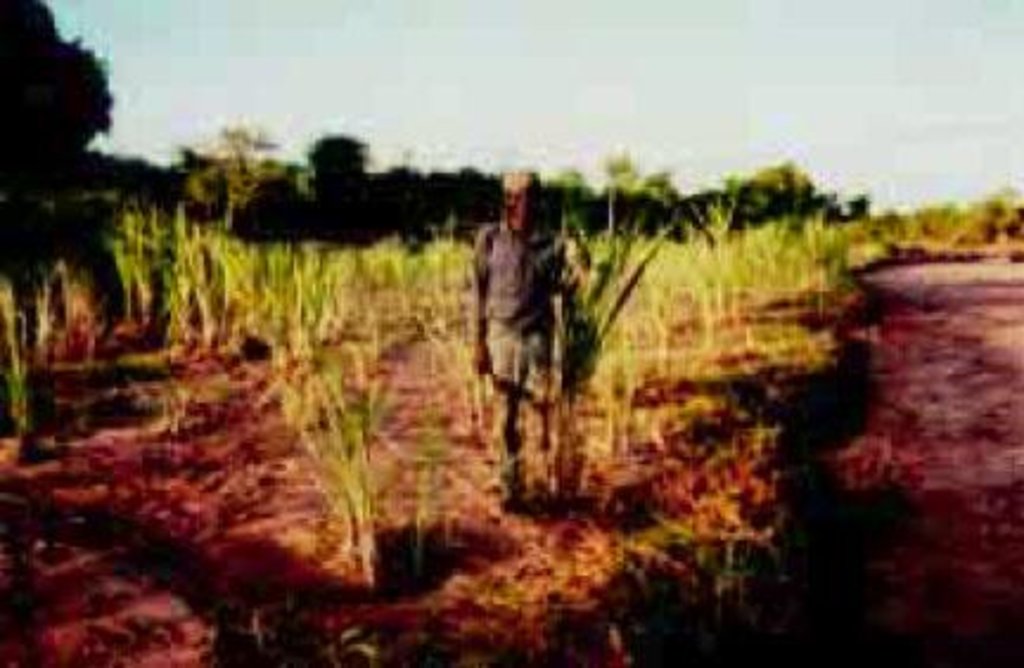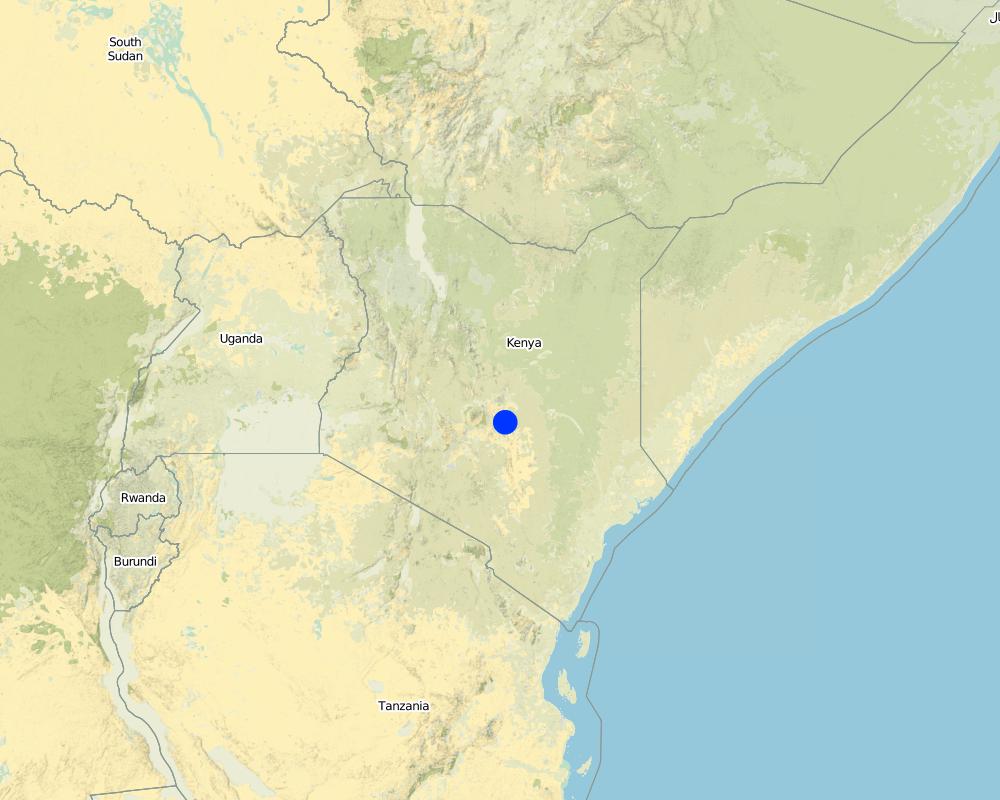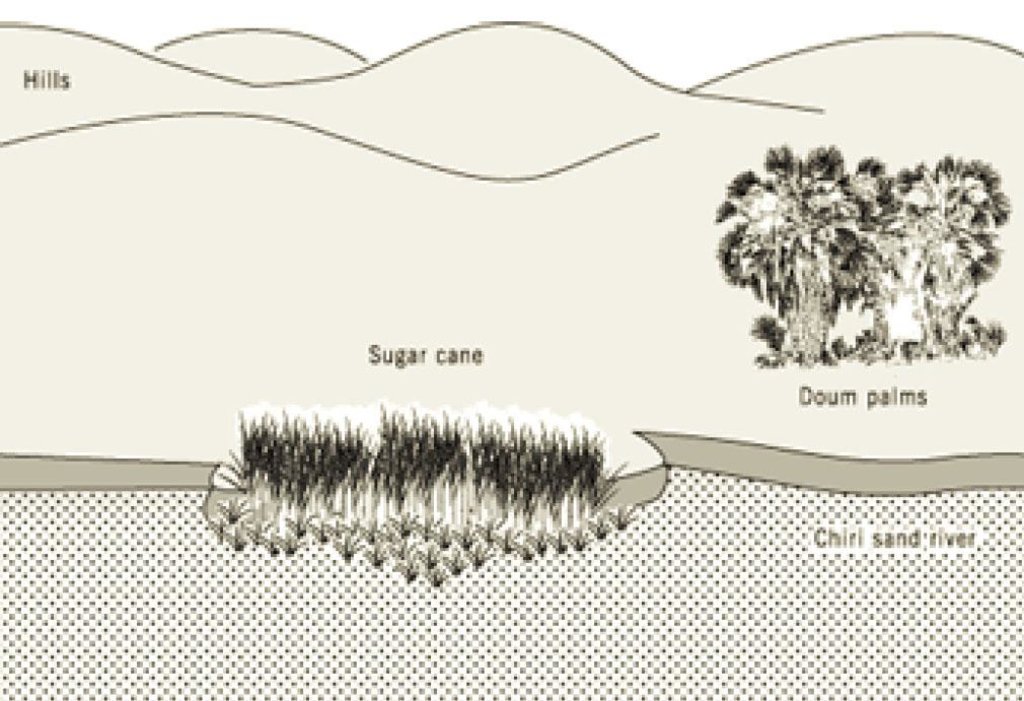Riverbed reclamation & silt trapping for sugarcane [เคนยา]
- ผู้สร้างสรรค์:
- การอัพเดท:
- ผู้รวบรวม: Kithinji Mutunga
- ผู้เรียบเรียง: –
- ผู้ตรวจสอบ: David Streiff, Alexandra Gavilano
Kyanda (Kikamab)
technologies_1096 - เคนยา
ดูส่วนย่อย
ขยายทั้งหมด ย่อทั้งหมด1. ข้อมูลทั่วไป
1.2 รายละเอียดที่ติดต่อได้ของผู้รวบรวมและองค์กรที่เกี่ยวข้องในการประเมินและการจัดเตรียมทำเอกสารของเทคโนโลยี
ผู้เชี่ยวชาญ SLM:
Ngati Mbuvi
MOARD
เคนยา
ผู้เชี่ยวชาญ SLM:
Mwendwa Linus
MOARD
เคนยา
ชื่อขององค์กรซึ่งอำนวยความสะดวกในการทำเอกสารหรือการประเมินเทคโนโลยี (ถ้าเกี่ยวข้อง)
Food and Agriculture Organization of the United Nations (FAO) - อิตาลี1.3 เงื่อนไขการใช้ข้อมูลที่ได้บันทึกผ่านทาง WOCAT
ผู้รวบรวมและวิทยากรหลักยอมรับเงื่อนไขเกี่ยวกับการใช้ข้อมูลที่ถูกบันทึกผ่านทาง WOCAT:
ใช่
2. การอธิบายลักษณะของเทคโนโลยี SLM
2.1 การอธิบายแบบสั้น ๆ ของเทคโนโลยี
คำจำกัดความของเทคโนโลยี:
Silt harvesting on riverbeds to maximise sugarcane growing in semi arid area
2.2 การอธิบายแบบละเอียดของเทคโนโลยี
คำอธิบาย:
The technology first involves fencing off part of a riverbed with cut thorn scrub in order to keep livestock away. The enclosed area is then mulched with brushwood and herbaceous materials in places. Sugar cane is planted and harvested piecemeal when mature. Kamuti plants a perennial grass (Cynodon dactylon) between the canes to help bind the sand. This exercise has been done, incrementally, over a series of seasons, enclosing an increasingly large area. When the rains return and the river flows, floodwater passes through and over the sugar cane and silt is deposited as the flow is slowed.
Purpose of the Technology: This initiative is categorized as an agronomic/vegetative measure, for reclamation of land. Its purpose is to increase water stored in the soil and to increase fertility by sediment harvesting, as a way of making land productive, while simultaneously addressing riverbed erosion. Farm income increase from the sale of sugar cane is the main production/ socio-economic benefit, while the ecological benefits include sediment accumulation, soil (ie riverbed and bank) loss reduction, soil cover improvement, increase in soil moisture and increase in soil fertility.
Establishment / maintenance activities and inputs: The action involves cutting tree branches, trimming pegs about 1m long, and hammering these pegs into the bed of the sand river, parallel to the bank, enclosing a long narrow strip. This initial strip may be 10 metres wide in a riverbed of 100 meters wide. The tree branches and trimmings are used to form a brushwood-netting barrier, which protects the area from livestock, and simultaneously slows the river flow and traps sediments. To further strengthen the barrier, star grass (Cynodon dactylon) is planted along the line of the fence. Inside the fenced-off area, sugar cane cuttings are buried at a depth of 0.4 m, and the same grass planted between the canes. The area is mulched with brushwood, which rots down to increase organic matter in the soil. These cuttings sprout and an intercrop of grass and sugar cane is the result. Maintenance comprises repairing the fence and cutting grass for mulching. No special tools are required. To be effective, the technology requires mulching every season, as the old mulch is covered by the silt load during the rainy period. The perimeter fence is maintained seasonally and requires considerable material. Occasionally when the rainfall is heavy, the sugar cane is swept away by floods and needs replacing.
Natural / human environment: The farm on which this technology is applied is in the arid far-north of Mwingi District. During the rainy season the farm can be inaccessible. The farmer, who is over 60 years of age, lives with his wives and children in what effectively forms a mini-village. The annual average rainfall in this area is barely 500 mm, and famine years are common. Temperatures are consistently high. The farm borders a dry sand riverbed.
2.3 รูปภาพของเทคโนโลยี
2.5 ประเทศภูมิภาค หรือสถานที่ตั้งที่เทคโนโลยีได้นำไปใช้และได้รับการครอบคลุมโดยการประเมินนี้
ประเทศ:
เคนยา
ภูมิภาค/รัฐ/จังหวัด:
Eastern Province
ระบุการกระจายตัวของเทคโนโลยี:
- กระจายไปอย่างสม่ำเสมอในพื้นที่
If the Technology is evenly spread over an area, specify area covered (in km2):
0.01
If precise area is not known, indicate approximate area covered:
- < 0.1 ตร.กม.(10 เฮกตาร์)
แสดงความคิดเห็น:
Total area covered by the SLM Technology is 0.01 km2.
This technology is along a riverbed and it is not adapted by other farmers
Map
×2.6 วันที่การดำเนินการ
ถ้าไม่รู้ปีที่แน่นอน ให้ระบุวันที่โดยประมาณ:
- มากกว่า 50 ปี (แบบดั้งเดิม)
2.7 คำแนะนำของเทคโนโลยี
ให้ระบุว่าเทคโนโลยีถูกแนะนำเข้ามาอย่างไร:
- เป็นส่วนหนึ่งของระบบแบบดั้งเดิมที่ทำก้นอยู่ (> 50 ปี)
ความคิดเห็น (ประเภทของโครงการ เป็นต้น) :
Farmer own intiative
3. การจัดประเภทของเทคโนโลยี SLM
3.1 วัตถุประสงค์หลักของเทคโนโลยี
- ปรับปรุงการผลิตให้ดีขึ้น
- ลด ป้องกัน ฟื้นฟู การเสื่อมโทรมของที่ดิน
3.2 ประเภทของการใช้ที่ดินในปัจจุบันที่ได้นำเทคโนโลยีไปใช้

พื้นที่ปลูกพืช
- การปลูกพืชยืนต้นที่ไม่มีเนื้อไม้
Perennial (non-woody) cropping - Specify crops:
- sugar cane
- star grass (Cynodon dactylon)
จำนวนของฤดูเพาะปลูกต่อปี:
- 2
ระบุ:
Longest growing period in days: 75 Longest growing period from month to month: Mar - May Second longest growing period in days: 60 Second longest growing period from month to month: Nov - Dec
แสดงความคิดเห็น:
Main crop: star grass (Cynodon dactylon) and sugar cane
Major land use problems (compiler’s opinion): Extensive grazing of animals/unit area, uncontrolled felling and burning of tree in land preparation, low soil fertility due to continuous cultivation without conservation.
Major land use problems (land users’ perception): Low yields hence opening of large areas for cultivation. Difficult soils, hence ploughing during the rains. Infertile soils.
3.4 การใช้น้ำ
การใช้น้ำของที่ดินที่มีการใช้เทคโนโลยีอยู่:
- จากน้ำฝน
3.5 กลุ่ม SLM ที่ตรงกับเทคโนโลยีนี้
- การรบกวนดินให้น้อยที่สุด
- การเก็บเกี่ยวน้ำ
3.6 มาตรการ SLM ที่ประกอบกันเป็นเทคโนโลยี

มาตรการจัดการพืช
- A7: Others

มาตรการอนุรักษ์ด้วยวิธีพืช
- V2: หญ้าและไม้ยืนต้น

มาตรการอนุรักษ์ด้วยโครงสร้าง
- S6: กำแพง สิ่งกีดขวาง รั้วไม้ รั้วต่างๆ

มาตรการอนุรักษ์ด้วยการจัดการ
- M1: การเปลี่ยนรูปแบบของการใช้ประโยชน์ที่ดิน
แสดงความคิดเห็น:
Main measures: agronomic measures, vegetative measures, management measures
Type of agronomic measures: mulching, zero tillage / no-till
3.7 รูปแบบหลักของการเสื่อมโทรมของที่ดินที่ได้รับการแก้ไขโดยเทคโนโลยี

การกัดกร่อนของดินโดยน้ำ
- Wg (Gully erosion): การกัดกร่อนแบบร่องธารหรือการทำให้เกิดร่องน้ำเซาะ

การเสื่อมโทรมของดินทางด้านเคมี
- Cn (Fertility decline): ความอุดมสมบูรณ์และปริมาณอินทรียวัตถุในดินถูกทำให้ลดลงไป (ไม่ได้เกิดจากสาเหตุการกัดกร่อน)
แสดงความคิดเห็น:
Main type of degradation addressed: Wg: gully erosion / gullying
Secondary types of degradation addressed: Cn: fertility decline and reduced organic matter content
4. ข้อมูลจำเพาะด้านเทคนิค กิจกรรมการนำไปปฏิบัติใช้ ปัจจัยนำเข้า และค่าใช้จ่าย
4.1 แบบแปลนทางเทคนิคของเทคโนโลยี
ข้อมูลจำเพาะด้านเทคนิค (แบบแปลนทางเทคนิคของเทคโนโลยี):
Reclaiming part of sand river bed with Sugar cane
Kenya
Technical knowledge required for field staff / advisors: moderate
Technical knowledge required for land users: high
Main technical functions: increase / maintain water stored in soil
Secondary technical functions: sediment retention / trapping, sediment harvesting, increase in soil fertility
Mulching
Material/ species: grasses
Quantity/ density: 2
Remarks: grass scattered
Grass species: stargrass
Change of land use type: fencing off portion of river bed
4.2 ข้อมูลทั่วไปเกี่ยวกับการคำนวณปัจจัยนำเข้าและค่าใช้จ่าย
อื่นๆ หรือสกุลเงินประจำชาติ (ระบุ):
Kenya shilling
If relevant, indicate exchange rate from USD to local currency (e.g. 1 USD = 79.9 Brazilian Real): 1 USD =:
70.0
ระบุค่าเฉลี่ยของค่าจ้างในการจ้างแรงงานต่อวัน:
1.50
4.3 กิจกรรมเพื่อการจัดตั้ง
| กิจกรรม | Timing (season) | |
|---|---|---|
| 1. | fencing | after rains |
| 2. | mulching with bushes | before rains |
| 3. | planting of sugarcane | dry season |
| 4. | cuting grass for mulch | rainy season |
| 5. | fencing riverbed to keep off animals | after rain |
| 6. | planting grass | after rain |
4.4 ค่าใช้จ่ายของปัจจัยนำเข้าที่จำเป็นสำหรับการจัดตั้ง
แสดงความคิดเห็น:
Duration of establishment phase: 24 month(s)
4.5 การบำรุงรักษาสภาพหรือกิจกรรมที่เกิดขึ้นเป็นประจำ
| กิจกรรม | ช่วงระยะเวลา/ความถี่ | |
|---|---|---|
| 1. | fencing | dry season / when height goes down |
| 2. | mulching with trash | dry '' / after clearing |
| 3. | grass planting | dry / before rains |
| 4. | sugarcane planting | wet / end of rain |
| 5. | collection of mulch | dry / biannual |
| 6. | fencing | after rain /biannual |
| 7. | cutting grass for mulch | rainy /biannual |
| 8. | scatterin thorn bushes | during rain /biannual |
| 9. | fencing | after rain / each cropping season |
| 10. | spreading brushwood | after / annual |
4.6 ค่าใช้จ่ายของปัจจัยนำเข้าและกิจกรรมที่เกิดขึ้นเป็นประจำที่ต้องการการบำรุงรักษา (ต่อปี)
แสดงความคิดเห็น:
Machinery/ tools: oxen plough, 2 pangas , 2 hoes
the above cost were calculated in terms of purchase of tools,material and manday used.
4.7 ปัจจัยสำคัญที่สุดที่มีผลกระทบต่อค่าใช้จ่าย
ปัจจัยสำคัญที่สุดที่มีผลกระทบต่อค่าใช้จ่ายต่างๆ:
labour affects cost as it is required in large quantities
5. สิ่งแวดล้อมทางธรรมชาติและของมนุษย์
5.1 ภูมิอากาศ
ฝนประจำปี
- < 250 ม.ม.
- 251-500 ม.ม.
- 501-750 ม.ม.
- 751-1,000 ม.ม.
- 1,001-1,500 ม.ม.
- 1,501-2,000 ม.ม.
- 2,001-3,000 ม.ม.
- 3,001-4,000 ม.ม.
- > 4,000 ม.ม.
เขตภูมิอากาศเกษตร
- กึ่งแห้งแล้ง
- แห้งแล้ง
5.2 สภาพภูมิประเทศ
ค่าเฉลี่ยความลาดชัน:
- ราบเรียบ (0-2%)
- ลาดที่ไม่ชัน (3-5%)
- ปานกลาง (6-10%)
- เป็นลูกคลื่น (11-15%)
- เป็นเนิน (16-30%)
- ชัน (31-60%)
- ชันมาก (>60%)
ธรณีสัณฐาน:
- ที่ราบสูง/ที่ราบ
- สันเขา
- ไหล่เขา
- ไหล่เนินเขา
- ตีนเนิน
- หุบเขา
ระดับความสูง:
- 0-100 เมตร
- 101-500 เมตร
- 501-1,000 เมตร
- 1,001-1,500 เมตร
- 1,501-2,000 เมตร
- 2,001-2,500 เมตร
- 2,501-3,000 เมตร
- 3,001-4,000 เมตร
- > 4,000 เมตร
5.3 ดิน
ค่าเฉลี่ยความลึกของดิน:
- ตื้นมาก (0-20 ซ.ม.)
- ตื้น (21-50 ซ.ม.)
- ลึกปานกลาง (51-80 ซ.ม.)
- ลึก (81-120 ซ.ม.)
- ลึกมาก (>120 ซ.ม.)
อินทรียวัตถุในดิน:
- ปานกลาง (1-3%)
- ต่ำ (<1%)
(ถ้ามี) ให้แนบคำอธิบายเรื่องดินแบบเต็มหรือระบุข้อมูลที่มีอยู่ เช่น ชนิดของดิน ค่า pH ของดินหรือความเป็นกรดของดิน ความสามารถในการแลกเปลี่ยนประจุบวก ไนโตรเจน ความเค็ม เป็นต้น:
Topsoil organic matter: Becomes medium after the technology
Soil drainage / infiltration is medium - good
Soil water storage capacity is very low - medium
5.6 ลักษณะของผู้ใช้ที่ดินที่นำเทคโนโลยีไปปฏิบัติใช้
รายได้ที่มาจากนอกฟาร์ม:
- 10-50% ของรายได้ทั้งหมด
ระดับของความมั่งคั่งโดยเปรียบเทียบ:
- จน
- พอมีพอกิน
ระดับของการใช้เครื่องจักรกล:
- งานที่ใช้แรงกาย
- การใช้กำลังจากสัตว์
ระบุลักษณะอื่นๆที่เกี่ยวข้องของผู้ใช้ที่ดิน:
Population density: < 10 persons/km2
Annual population growth: 3% - 4%
5% of the land users are very rich and own 33% of the land.
10% of the land users are rich and own 25% of the land.
30% of the land users are average wealthy and own 12% of the land.
40% of the land users are poor and own 8% of the land.
15% of the land users are poor and own 21% of the land.
Off-farm income specification: most of harvest are low and hence dependent on off farm income.
Level of mechanization: Animal traction is used for assembling the thorny bushes and for marking farrows
5.8 กรรมสิทธิ์ในที่ดิน สิทธิในการใช้ที่ดินและสิทธิในการใช้น้ำ
กรรมสิทธิ์ในที่ดิน:
- เป็นแบบชุมชนหรือหมู่บ้าน
- รายบุคคล ไม่ได้รับสิทธิครอบครอง
สิทธิในการใช้ที่ดิน:
- เข้าถึงได้แบบเปิด (ไม่ได้จัดระเบียบ)
- เกี่ยวกับชุมชน (ถูกจัดระเบียบ)
6. ผลกระทบและสรุปคำบอกกล่าว
6.1 ผลกระทบในพื้นที่ดำเนินการ (On-site) จากการใช้เทคโนโลยี
ผลกระทบทางด้านเศรษฐกิจและสังคม
การผลิต
การผลิตพืชผล
แสดงความคิดเห็น/ระบุ:
Sugar cane
รายได้และค่าใช้จ่าย
รายได้จากฟาร์ม
แสดงความคิดเห็น/ระบุ:
Sugar cane
ผลกระทบด้านนิเวศวิทยา
วัฐจักรน้ำหรือน้ำบ่า
น้ำไหลบ่าที่ผิวดิน
จำนวนก่อน SLM:
60
หลังจาก SLM:
20
ดิน
ความชื้นในดิน
สิ่งปกคลุมดิน
การสูญเสียดิน
จำนวนก่อน SLM:
12
หลังจาก SLM:
5
การหมุนเวียนและการเติมของธาตุอาหาร
6.4 การวิเคราะห์ค่าใช้จ่ายและผลประโยชน์ที่ได้รับ
ผลประโยชน์ที่ได้รับเปรียบเทียบกับค่าใช้จ่ายในการจัดตั้งเป็นอย่างไร (จากมุมมองของผู้ใช้ที่ดิน)
ผลตอบแทนระยะสั้น:
ด้านบวกเล็กน้อย
ผลตอบแทนระยะยาว:
ด้านบวกอย่างมาก
ผลประโยชน์ที่ได้รับเปรียบเทียบกับค่าใช้จ่ายในการบำรุงรักษาหรือต้นทุนที่เกิดขึ้นซ้ำอีก เป็นอย่างไร (จากมุมมองของผู้ใช้ที่ดิน)
ผลตอบแทนระยะสั้น:
ด้านบวก
ผลตอบแทนระยะยาว:
ด้านบวกอย่างมาก
6.5 การปรับตัวของเทคโนโลยี
- 1-10%
ถ้ามีข้อมูลให้บอกปริมาณด้วย (จำนวนของครัวเรือนหรือครอบคลุมพื้นที่):
30 households (1% of the area stated)
Of all those who have adopted the Technology, how many did so spontaneously, i.e. without receiving any material incentives/ payments?
- 91-100%
แสดงความคิดเห็น:
30 land user families have adopted the Technology without any external material support
Comments on spontaneous adoption: estimates
There is a moderate trend towards spontaneous adoption of the Technology
Comments on adoption trend: after farmer tour organised by the PFI most are attempting. At least five farmers had adopted the innovation by the beginning of 1999 (exact figures not available). This is a particularly site-specific system, and thus wide replication is simply not possible. It is only relevant to those who have farms bordering sand rivers with wide beds.
6.7 จุดแข็ง / ข้อได้เปรียบ / โอกาสของเทคโนโลยี
| จุดแข็ง / ข้อได้เปรียบ / โอกาสในทัศนคติของผู้รวบรวมหรือวิทยากรหลัก |
|---|
| This innovation demonstrates how productive use can be made of sub-surface moisture in sand rivers in arid areas while simultaneously protecting the riverbed and bank from erosion |
| Farm income increase through land reclamation |
6.8 จุดอ่อน / ข้อเสียเปรียบ / ความเสี่ยงของเทคโนโลยีและวิธีการแก้ไข
| จุดอ่อน / ข้อเสียเปรียบ / ความเสี่ยงในทัศนคติของผู้รวบรวมหรือวิทยากรหลัก | มีวิธีการแก้ไขได้อย่างไร |
|---|---|
|
Planting within a riverbed is, strictly speaking, against regulations. |
Such technologies should not be attempted without consulting the local agricultural office. |
| The fence is constructed with thorn bush cuttings which have to be constantly replenished |
A live fence is recommended as an alternative to constantly having to replenish the fence with cut thorn bush. The fence is required to avoid grazing of the cane by domestic livestock. |
7. การอ้างอิงและการเชื่อมต่อ
7.1 วิธีการและแหล่งข้อมูล
7.2 การอ้างอิงถึงสิ่งตีพิมพ์
หัวข้อ, ผู้เขียน, ปี, หมายเลข ISBN:
Farm management Guidelines. 1989.
ชื่อเรื่อง ผู้เขียน ปี ISBN:
MOA, Nairobi
หัวข้อ, ผู้เขียน, ปี, หมายเลข ISBN:
Kithinji M., Critchley W. 2001. Farmers' initiatives in land husbandry: Promising technologies for the drier areas of East Africa. RELMA Technical Report series no. 27
ลิงก์และโมดูล
ขยายทั้งหมด ย่อทั้งหมดลิงก์
ไม่มีลิงก์
โมดูล
ไม่มีโมดูล





